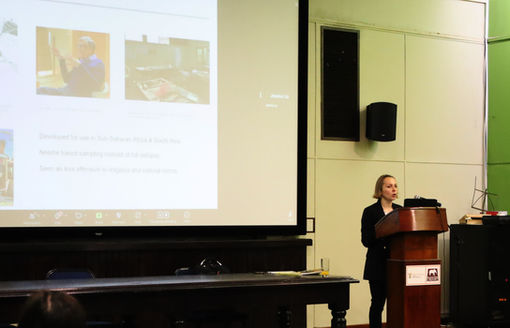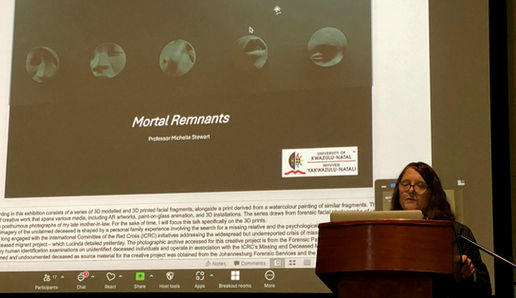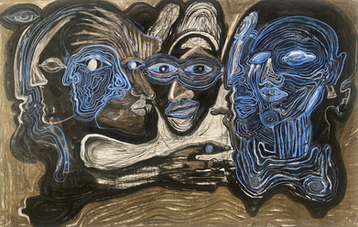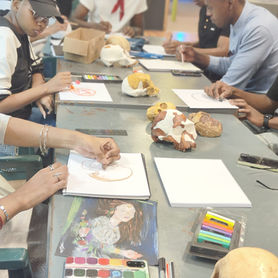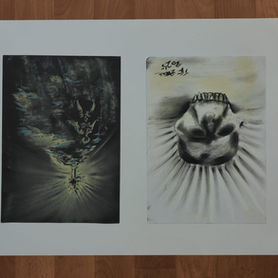“ART, SCIENCE AND THE DECEASED BODY: TOWARDS A DUTY OF CARE”
PANEL DISCUSSION, EXHIBITION AND WORKSHOP SERIES
13-16 May 2025
Hosted by the University of KwaZulu-Natal
in collaboration with the KwaZulu-Natal Museum

ABOUT
Exploring Art, Science and the decseased body
Nowadays, possessing, managing, and presenting human remains within the settings of museums or the forensic – medico environment or displaying related imagery within an art space or context has come under increased scrutiny. The notion of human remains taking on the status as objects and medical or scientific specimens is also the subject of broad debate especially within the context of post-colonial legacies that exist within medical, academic, and cultural institutions and museums. Moreover, contemporary artists who confront postmortem subject matter often do so with an acute awareness of the ethical obligation to the corpse and the contemporary taboo often surrounding such representation.
The central aim of this interdisciplinary event is to explore the concept of mortal remains and the ethical considerations surrounding their representation, management, and display at the intersection of art and science. Hosted at the KwaZulu-Natal Museum in Pietermaritzburg, South Africa, the event will unfold through a hybrid programme featuring two panel discussions, an exhibition, and a two-day workshop. Bringing together local and international participants—including artists, social scientists, forensic experts, and curators—the event seeks to foster meaningful dialogue and collaboration across disciplines. By engaging with diverse perspectives, it aims to critically examine how the deceased body is understood, treated, and portrayed in contemporary society. The initiative emphasizes ethical reflection and creative engagement, offering a platform to consider both scientific and artistic approaches to death, memory, and representation in culturally sensitive and socially relevant ways.
VENUE - KZN MUSEUM
The KwaZulu-Natal Museum, located in Pietermaritzburg, is one of South Africa’s leading cultural and natural history museums. Established in 1904, it offers a rich and immersive experience that showcases the region’s diverse heritage. The Museum features extensive exhibits from cultural history, including early settler life, and archaeological finds. Its natural science displays range from dioramas of local wildlife to collections of fossils and insects. With a strong focus on education and research, the Museum is also home to collections and a specialist library. It serves as a vibrant space for learning, reflection, and community engagement. The KwaZulu-Natal Museum is dedicated to serving the people of South Africa by interpreting material evidence of the natural and cultural world in order to increase knowledge, understanding and appreciation of the nation’s wealth of history and biodiversity.



EVENT SHEDULE
“ART, SCIENCE AND THE DECEASED BODY: TOWARDS A DUTY OF CARE”
PANEL DISCUSSION, EXHIBITION AND WORKSHOP SERIES
13 May 2025
09:30 am -03:00pm
PANEL DISCUSSION 1
“THE ETHICS AND CONSIDERATIONS OF MANAGING, REPRESENTING AND CURATING HUMAN REMAINS AT THE INTERSECTION OF ART AND SCIENCE”
This panel will bring together a diverse group of local and international guest presenters, including artists, scholars, and specialists whose research and expertise span creative practice , curatorial practices, forensic sciences, archaeology, and medico-social sciences.
09:30 am -02:15 pm
ART/ SCIENCE
WORKSHOP (PART 1)
"BETWEEN MAGIC AND REALISM": HUMAN REMAINS IN THE MUSEUM COLLECTION
Session
Venue
Date
Time
KZN MUSEUM
KZN MUSEUM
14 May 2025
EXHIBTION OPENING
KZN MUSEUM
14 May 2025
02:30 pm -04:00 pm
PANEL DISCUSSION 2
"ARTISTS' TALKS"
The Artists' Talks will feature a discussion on artworks by both local and international artists, exploring how their works engage with medico-forensic, museological, and scientific documentation related to mortal remains. All artworks will be exhibited in the museum space.
KZN MUSEUM
15 May 2025
9:30 am -03:30 pm
ART/ SCIENCE
WORKSHOP (PART 2)
"BETWEEN MAGIC AND REALISM": HUMAN REMAINS IN THE MUSEUM COLLECTION
16 May 2025
09:30 am -03:00pm
KZN MUSEUM
PANEL DISCUSSION 1
“THE ETHICS AND CONSIDERATIONS OF MANAGING, REPRESENTING AND CURATING HUMAN REMAINS AT THE INTERSECTION OF ART AND SCIENCE”
Dr Halina Suwalowska (Keynote)
Ethics of the Unseen: Caring for the Dead in Global Health Crises
This presentation examines the ethical issues involved in caring for the dead in global health. From Ebola to COVID-19, global health responses have often prioritised the living, overlooking the ethical and cultural obligations owed to the dead. The treatment of unidentified bodies -many from marginalised communities-raises urgent questions about dignity, justice, and public trust. The presentation explores these challenges alongside the legacy of human remains in museums, highlighting how interdisciplinary approaches, including art and heritage, can help reframe care for the dead as a vital yet neglected dimension of global health ethics.
Lucinda Evert (Keynote)
Dignity in death and the role of humanitarian forensic action
Dignity in death is a fundamental principle guiding humanitarian forensic action. In contexts of conflict, disaster, or migration, forensic teams work to locate, recover, and identify the dead—restoring their names, stories, and humanity. Through collaboration between forensic scientists, artists and affected communities this process not only allows us to bring answers to families and communities but also supports justice, accountability, and collective memory.
Jay Savage
WHAT IF THERE ARE NO REMAINS - A Music and Technology Production Gives Voice To The (Presumed) Dead
A decade after the loss at sea of three professional sailors, two family members of the boat’s skipper undertook an artistic project to tell their story - but to tell it through a creative collaboration, not in a simple narrative format but through a combination of interpretive music, actual voice recordings and interactive digital means in order to navigate issues of personal loss in the specific light of ambiguous loss and complex grief. The broader purpose of this South African/Dutch project was to create a forum and give voice to the increasing number of bereaved who have experienced loss of loved ones in unknown, unresolved - and unresolvable - circumstances. The duties of care and the failures by those whose nominal duty it was to provide care in all senses of tragedy, is integral to the project and its creation, as is a route to process the lasting remnants of loss in a void.
Dr Mark, Dr Rebecca Crozier, Dr Christopher Rynn
Faces from the past: digital, facial reconstruction in the new Perth Museum, Scotland
On March 31, 2024, the new Perth Museum opened to wide public acclaim. It converted the historic City Hall as the display focus for the region’s collections of archaeology and history. It also houses the Stone of Scone/Stone of Destiny until such time as it is needed once more for a coronation in Westminster Abbey. The archaeology displays tell the story of human dwelling in what is now Perth & Kinross, Scotland. Mostly we tell that story through the things people left behind but we wanted to emphasise the humanity of the story in a very immediate way. The route we chose to do this was through the digital facial reconstruction of known individuals across time and place. Here we introduce the strategy, processes and new research we followed to people the displays with ancestral faces.
PANEL DISCUSSION 2
ARTIST’S TALKS
Limo Velapi
The Sculpted Archive: Digitally Carved, Virtually Kept
My digital sculpture explores the intersection of forensic aesthetics, museological documentation, and digital preservation. The artwork presents a digitally sculpted representation of the deceased, drawing inspiration from traditional stone memorials, tomb effigies, and wax replicas, while reimagining these forms through contemporary digital techniques. Using forensic facial reconstruction methods as a technical foundation, the piece engages with themes of representation, memory, and the ethics of preservation. A key feature of the work is its interactive augmented reality (AR) component, which allows viewers to explore the sculpture from multiple perspectives. This immersive experience challenges the boundaries between the physical and digital realms of remembrance, inviting reflection on the evolving ways in which we document and honour the deceased.
Anna Suwalowska
Death from the Mind’s Eye
Anna draws inspiration from her background in dental technology and her longstanding interest in museum collections as she explores the subconscious through automatism in her artistic practice. In this talk, she will share her journey and evolution as an artist, focusing on her unique project that investigates autopsy and the stories of unidentified bodies. Developed through her distinctive creative approach and in collaboration with academics, the project addresses ethical challenges and perceptions surrounding death. Anna will also reflect on the intersection of art and science in her work, discussing how historical medical narratives have influenced her artistic vision.
Raja Oshi
Unknown
My artwork is profoundly shaped by the ongoing conflict in Sudan and across the globe, with a particular focus on its devastating impact on vulnerable populations, especially women and children. It is a reflection of my sorrow, emotions, and the harsh realities we are currently facing. The loss of life weighs heavily on me—people dying on the streets, their bodies left exposed, unburied, and dishonoured. These bodies, abandoned and unknown, are left to the mercy of the elements and stray animals.
Dr Rania Fouad
Traces from the Forgotten
Aspirations for immortality, turned into subjects for the benefit of modern scientists, governments, and collectors. We question the effects of time, as we excavate and unearth our limited truths. The traces that we find are exported and resort to objective spectacle , possibly against the original purposes for which they were created. By painting CT scans of different mummifications , I am contemplating this situation; in which, the ethereal system of dreams continues to be modified, and de-;represented, classified and physically over-examined. When you place an ethereal energy into the confinement of scientific quantification , a state of ambiguity will always react upon its scientific representation . In a sense the enigma of an object and itself as a subject, will always superimpose onto the direct illustration of its physical body. Reimagined here, are suggestive representations of the fragilities that carry this time transported density, as it is confined in its frail, outer shell.
Professor Michelle Stewart
Mortal Remnants
I am presenting a series of digitally modelled and 3D printed facial fragments, based on forensic photographs of unclaimed deceased individuals. Using white digital clay, which resembles plaster, softens the harshness of these images, creating a veil that distances the viewer from the stark reality of death. Inspired by the tradition of death masks, the series preserves the likeness of the deceased while removing the trauma of decay. The white clay symbolizes preservation and artifice, turning unsettling forensic photos into a conceptual representation. This work questions how we memorialize death and reflects on technology's influence on memory and representation.
Anaïs Chabeur
Visions for Crossing
Visions for Crossing is an artistic research focusing on the “laying out” of the corpse, an ancestral practice that consists in the cleaning, grooming and dressing of the body after death. The project is conducted in dialogue with people who practice this act in different contexts : nurses, religious washers and funeral home workers. With the aim to create an audio-visual installation, the ethical and aesthetic questions around the representation of the deceased and their care are central. In this presentation, I will offer insight on my artistic process.
Professor Yane Bakreski
Sacred Remains
“Sacred Remains” explores the intersection of technology and the human body, using digital reconstruction to create a modern equivalent of Byzantine iconography. Just as Byzantine art idealized the human form to reflect a higher, divine truth, the digital nude evokes perfection and immortality, untouched by time and decay. This work questions whether digital technology can offer a form of immortality, preserving and perfecting the human body in a way that mirrors the timeless beauty and spiritual transcendence seen in Byzantine icons. It probes the potential for technology to create idealized, eternal representations of humanity.
Sherif El Azma
Offerings presented, on trays
The thieves left the 2-ton slabs, those used by the priests during their offerings to the gods.
No wooden coffin, just the bottom half of the stone sarcophagus.
Ground penetrating Radars are searching underground for chambers,
Empty spaces that can lead to more empty spaces.
Shapes and dimensions of rooms carved by bodies performing endless ritual.
And when these rooms are found, the geographies of spaces can communicate in ways.
All matter is carved out of its own movement, a prototype.
Not a monument to stillness.
An investigation into prototypic spaces yields many associations that weave from curiosity, exoticism, lost history and speculative geometries.
Living in antiquity has become shrouded in more fiction than there is solid fact. A fiction that levitates like a heavy gas but will sing its narratives slowly.
Peter Stewart
Mfowethu Phezulu (In Memoriam Michael Gasa), 2025.
Bonginkosi Michael Gasa died on 18 April 2019, aged 55. His death was unexpected; a shock.
I met Michael Gasa in 2001, soon after he started selling wood carvings next to Old Main Rd, Botha’s Hill, KZN. In time, I helped Gasa mount a solo exhibition at the Tatham Art Gallery, Pietermaritzburg (2005). In 2010 Gasa’s sculpture The Dream Series: Baboon King Ascends the Throne was selected for the prestigious touring exhibition Jabulisa: The Art of KwaZulu Natal. The work was purchased by Tatham Art Gallery for its permanent collection.
The work Mfowethu Phezulu primarily consists of a Michael Gasa sculpture of a cow head (from my collection) and a sound piece assembled from the singing with drum and horn accompaniment of Hlabazihlangane (Corinthian Church of South Africa) members during Michael Gasa’s funeral at the Gasa family homestead at Shaya Moya, Valley of 1000 Hills. The work alludes to the Zulu practice of Ukubuyiswa (a ceremony to bring a departed person’s spirit back home).
Wesley Flanagan
Portrait Miniature of a Lady, 2025
This portrait depicts a young woman in late Georgian attire set in watercolor on ivory, in a gilt metal frame. The reverse contains a lock of the sitter’s hair, intricately arranged with gold thread and seed pearl - a poignant token of affection or remembrance. Such miniatures were cherished personal keepsakes, often commissioned by families of means as expressions of love, memory, or mourning. The craftsmanship and materials suggest it was created in England during the late Georgian or early Regency period. I found this piece on auction, once a keepsake. With the use of AI I have been able to bring her to life again around 230 years after her death.
ABSTRACTS
PRESENTERS
Meet the artists, scientists and experts who will participate in this dynamic interchange.
PANEL PRESENTATIONS
IMAGE GALLERY

EXHIBITION: TOWARDS A DUTY OF CARE
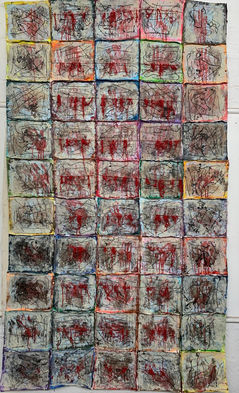
WORKSHOP
"BETWEEN MAGIC AND REALISM"
HUMAN REMAINS IN THE MUSEUM COLLECTION
The workshop is a two part series and will be conducted on the 13th and 16th May. This workshop is part of the Beyond Physical Form platform, founded by artist Anna Suwalowska, who guides participants through imaginative methods drawn from her own artistic practice. The aim is to reveal the multilayered nature of reality and explore the artistic power of the imagination.
While directed by Anna, the workshop will be joined by Dr Halina Suwalowska (University of Oxford) who will introduce key ethical considerations around presence and display of human remains in museum contexts. Professor Michelle Stewart will contribute by reflecting on the Exhibition in relation to the thematic focus of the workshop and will introduce the concept of Augmented Reality (AR) digital curation. Mr Wesley Flanagan will provide historical context for replicas of human remains and related archaeological artefacts, which will serve as sources of inspiration throughout the workshop.
Participants will explore the museum as a space of inspiration at the intersection of art and science, with a particular focus on the history of displaying and curating human remains. Through discussion and creative response, the workshop will invite artists to reflect on contemporary and personal attitudes toward these displays, while considering the ethical dimensions involved.
Artists will be encouraged to find their own sources of inspiration, weaving these themes into their individual practices. The museum will be approached as a mindscape of mortality—a space where knowledge, memory, and imagination converge.
The workshop will also explore connections between the human and animal worlds, belief systems, spirits, and nature—inviting participants to create personal mythologies and express diverse ways of understanding care, death, and remembrance.





